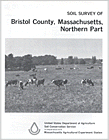Soil Survey of Bristol County, Massachusetts
NORTHERN PART

The following Map Unit Description is from the 1981 Soil Survey of Bristol County, NORTHERN Part. Please note: map unit symbols are DIFFERENT for Bristol North and Bristol South reports, do NOT use these descriptions for Bristol South.
Ng-Ninigret fine sandy loam. This soil is deep, nearly level, and moderately well drained. It is on glacial outwash plains. Slopes are smooth or gently undulating and are generally 100 to 500 feet long. The mapped areas are irregular in shape and range from 5 to 25 acres in size.
Typically, the surface layer is very friable, dark brown fine sandy loam about 6 inches thick. The subsoil is friable, yellowish brown fine sandy loam and is 17 inches thick. It has yellowish red and pale brown mottles in the lower half. The substratum to a depth of 63 inches is friable, yellowish brown loamy fine sand. It has light brownish gray and reddish yellow mottles in the upper 17 inches and is light brownish gray fine sand below this.
Included with this soil in mapping are areas of Agawam, Sudbury and Windsor soils that are generally less than 4 acres in size. Also included are small areas of Ninigret soil that has slopes as much as 8 percent. Included soils make up about 20 percent of the map unit.
Permeability is moderately rapid in the subsoil and rapid in the substratum. Available water capacity is moderate. Reaction is very strongly acid or medium acid. The root zone extends into the loose substratum. Root growth is restricted by a seasonal high water table in the lower part of the subsoil.
This soil has good potential for farming, and most acreage has been farmed. It has fair to poor potential for urban use and poor potential for sanitary waste disposal facilities. The soil has good potential for trees and for openland and woodland wildlife habitat. Some areas of soil have been developed for homesites, and some has reverted to or has been planted in trees.
The soil is well suited to cultivated crops although the seasonal high water table generally keeps this soil wet in the early spring and delays farming operations. Good tilth is easily maintained. The hazard of erosion is slight. Artificial drainage is generally not needed for hay and pasture. Conservation management includes installing field drainage if needed, improving tilth, and increasing organic-matter content. If this soil is farmed, the use of minimum tillage, cover crops, and grasses and legumes in the cropping system help to reduce runoff. Mixing crop residue and animal manure into the plow layer helps to improve tilth and increases organic-matter content. Proper stocking rates, deferred grazing, and pasture rotation are management practices that help to maintain desirable pasture plants.
The soil is well suited to trees, but only a small acreage is wooded. Limitations are slight for this use, and productivity is high. Important tree species are eastern white pine, red oak, and white oak.
The soil is limited for most urban use because of the seasonal high water table. It has limitations for sanitary waste disposal facilities because of the seasonal high water table and moderately rapid permeability in the substratum. Capability subclass IIw.
Ninigret Official Series Description